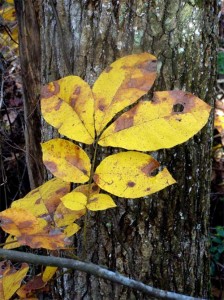
Consider the hickory
By Ken Moore
Autumn colors are far from over. Recently, I have come close to pulling off the road simply to consider the hickory trees.
Somewhere between the colors of mustard-gold and lemon-yellow are the glowing autumn colors of the hickories. Some forests are almost winter bare except for hickory’s fire of gold spreading throughout.
This time of year offers close-up hickory-leaf opportunities, because those compound leaves (several leaflets forming a single leaf) frequently fall to the ground retaining all their leaflets.
Most hickory species have five to nine leaflets, except the pecan, with twice as many leaflets and an oblong nut unlike the round nuts of the hickories.
I most frequently encounter mockernut hickory, Carya tomentosa, which has large terminal buds at the ends of the twigs, large leaves (leaflets) and visible dark hairs on the petioles and leaf undersides. The often quite tasty nut is inside a thick round husk sometimes as large as a silver dollar.
Another tasty hickory is the shagbark hickory, C. ovata, which, as the name describes, has bark that peels away in long vertical strips, easy to identify. Mockernut hickory bark is deeply grooved and gives no indication of shedding.
Hickory is one of our most valuable forest trees. Valued as firewood for warmth and flavorful cooking, it also has a rich heritage in medicinal use and practical implement making. The wood is tough, and many an old timer will proudly display a hickory walking stick.
If you visit the American Indian Heritage Celebration in Raleigh this Saturday you will most likely see hickory wood being used in some of the Native-American crafts.
And now for something entirely different: consider the hickory twig girdler. Back in August, you may have noticed twigs with leaves scattered about on the ground. They are still obvious along trails and beneath specimen trees. Twigs, with one or more adjoining twigs holding dried leaves, are 10 to 30 or more inches long. It’s most likely a hickory twig, but as Dave Cook describes in The Piedmont Almanac, one of my favorite references, some girdlers may choose oak, persimmon or pecan.
You’ll notice a clean, chiseled cut around the twig at least halfway to the center. The adult girdler emerges in August-September and selects a number of twigs on a tree. It chews around the twig, leaving it dangling from the middle woody strands. It lays a single egg in one or more small incisions in the twig bark next to a leaf petiole scar. The egg hatches and a tiny larva bores beneath the thin bark layer, where it remains all winter.
The girdled twig falls to the ground from its own weight or wind action to lie in the leaf litter hidden from tree-top woodpecker predators. In spring and summer, the larva eats and matures beneath the bark and finally pupates at summer’s end, emerging as an adult to begin the cycle again.
With a sharp knife you may be able to find the egg or larva just beneath the bark layer close to the incision. A clever little critter is the twig girdler, and a mighty tree, the hickory, to host it so quietly.
Considering the hickory is more than enjoying the color!
from → Fall, Ken Moore's Flora



Comments are closed.